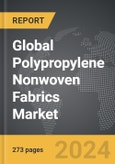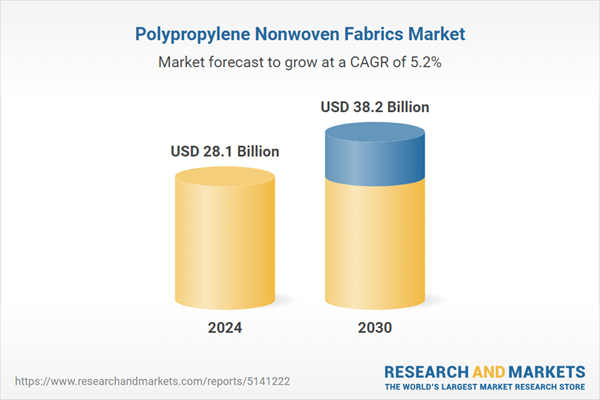The global market for Polypropylene Nonwoven Fabrics was valued at USD 28.1 Billion in 2024 and is projected to reach USD 38.2 Billion by 2030, growing at a CAGR of 5.2% from 2024 to 2030. This comprehensive report provides an in-depth analysis of market trends, drivers, and forecasts, helping you make informed business decisions.
Global Polypropylene Nonwoven Fabrics Market - Key Trends and Drivers Summarized
Polypropylene Nonwoven Fabrics: Revolutionizing Modern Textile Applications
Polypropylene nonwoven fabrics are versatile, engineered textiles made from polypropylene polymer. Unlike traditional woven fabrics, nonwoven fabrics are produced by bonding fibers together through mechanical, thermal, or chemical processes rather than weaving or knitting. The manufacturing process typically involves melt-blown and spunbond techniques, where polypropylene granules are melted and extruded through fine nozzles to form continuous fibers. These fibers are then laid down randomly to create a web, which is bonded together to form a cohesive fabric. The result is a lightweight, breathable, and strong material that can be tailored to meet specific performance requirements. The ability to produce nonwoven fabrics with varying densities, thicknesses, and properties makes them suitable for a wide range of applications.How Are Polypropylene Nonwoven Fabrics Utilized Across Different Industries?
Polypropylene nonwoven fabrics are extensively used across various industries due to their unique properties such as durability, flexibility, and cost-effectiveness. In the medical sector, they are employed to manufacture disposable surgical gowns, masks, and drapes, providing essential protection and hygiene. The hygiene industry utilizes these fabrics for products like diapers, sanitary napkins, and adult incontinence pads, where their high absorbency and softness ensure comfort and effectiveness. In the automotive industry, polypropylene nonwoven fabrics are used for interior components such as headliners, carpeting, and trunk liners, enhancing vehicle comfort and noise reduction. The construction sector benefits from these fabrics in applications such as geotextiles, roofing underlays, and insulation materials, where their strength and resistance to moisture contribute to building durability. Additionally, polypropylene nonwoven fabrics are used in agriculture for crop covers and weed control fabrics, helping improve crop yields and reduce pesticide use. These diverse applications highlight the critical role of polypropylene nonwoven fabrics in enhancing product performance and sustainability.What Are the Current Trends in Polypropylene Nonwoven Fabric Technology and Applications?
The technology and applications of polypropylene nonwoven fabrics are continuously evolving, driven by innovations aimed at improving their performance and expanding their use. One significant trend is the development of high-performance nonwoven fabrics with enhanced functionalities such as antimicrobial properties, UV resistance, and flame retardancy. Advances in manufacturing processes are enabling the production of finer and more uniform fibers, resulting in softer and more comfortable fabrics. The push towards sustainability is also leading to the creation of eco-friendly nonwoven fabrics made from recycled or bio-based polypropylene, addressing environmental concerns and regulatory pressures. Additionally, there is growing interest in the use of polypropylene nonwoven fabrics in advanced filtration systems, including air and water filters, where their fine fiber structure and high surface area improve filtration efficiency. The increasing adoption of nonwoven fabrics in smart textiles, which integrate electronic components for applications like wearable technology and sensor systems, is another notable trend. These developments reflect the ongoing efforts to innovate and maximize the potential of polypropylene nonwoven fabrics in modern industrial and consumer applications.What Factors Are Driving the Growth in the Polypropylene Nonwoven Fabric Market?
The growth in the polypropylene nonwoven fabric market is driven by several factors, reflecting the increasing demand for high-performance, versatile materials across various sectors. The expanding healthcare industry, with its need for disposable medical products and protective gear, is a significant driver for polypropylene nonwoven fabrics. Technological advancements in nonwoven fabric production and the development of high-performance and sustainable products are enhancing their attractiveness and broadening their applications. The growing awareness and adoption of hygiene products, such as diapers and sanitary napkins, are also propelling demand for these fabrics. Additionally, the automotive industry's focus on lightweight and noise-reducing materials is contributing to market growth. The construction sector's emphasis on durable and moisture-resistant materials for building applications further supports market expansion. Continuous research and development efforts to create innovative nonwoven fabrics with enhanced properties and broader application scopes ensure robust growth in the polypropylene nonwoven fabric market. These factors collectively underscore the essential role of polypropylene nonwoven fabrics in advancing material science and industrial applications.Report Scope
The report analyzes the Polypropylene Nonwoven Fabrics market, presented in terms of market value (USD Thousand). The analysis covers the key segments and geographic regions outlined below.Segments
Application (Hygiene, Medical, Industrial, Other Applications); Product Type (Spunbonded, Staples, Meltblown, Composite).Geographic Regions/Countries
World; United States; Canada; Japan; China; Europe (France; Germany; Italy; United Kingdom; Spain; Russia; and Rest of Europe); Asia-Pacific (Australia; India; South Korea; and Rest of Asia-Pacific); Latin America (Argentina; Brazil; Mexico; and Rest of Latin America); Middle East (Iran; Israel; Saudi Arabia; United Arab Emirates; and Rest of Middle East); and Africa.Key Insights:
- Market Growth: Understand the significant growth trajectory of the Spunbond Fabrics segment, which is expected to reach $20.9 Billion by 2030 with a CAGR of a 5.9%. The Staple Fabrics segment is also set to grow at 5.2% CAGR over the analysis period.
- Regional Analysis: Gain insights into the U.S. market, valued at $7.4 Billion in 2024, and China, forecasted to grow at an impressive 8.1% CAGR to reach $8.6 Billion by 2030. Discover growth trends in other key regions, including Japan, Canada, Germany, and the Asia-Pacific.
Report Features:
- Comprehensive Market Data: Independent analysis of annual sales and market forecasts in USD from 2024 to 2030.
- In-Depth Regional Analysis: Detailed insights into key markets, including the U.S., China, Japan, Canada, Europe, Asia-Pacific, Latin America, Middle East, and Africa.
- Company Profiles: Coverage of major players such as Asahi Kasei Corporation, Avgol Ltd., Berry Global Inc., Dow, Inc., DuPont de Nemours, Inc. and more.
- Complimentary Updates: Receive free report updates for one year to keep you informed of the latest market developments.
Why You Should Buy This Report:
- Detailed Market Analysis: Access a thorough analysis of the Global Polypropylene Nonwoven Fabrics Market, covering all major geographic regions and market segments.
- Competitive Insights: Get an overview of the competitive landscape, including the market presence of major players across different geographies.
- Future Trends and Drivers: Understand the key trends and drivers shaping the future of the Global Polypropylene Nonwoven Fabrics Market.
- Actionable Insights: Benefit from actionable insights that can help you identify new revenue opportunities and make strategic business decisions.
Key Questions Answered:
- How is the Global Polypropylene Nonwoven Fabrics Market expected to evolve by 2030?
- What are the main drivers and restraints affecting the market?
- Which market segments will grow the most over the forecast period?
- How will market shares for different regions and segments change by 2030?
- Who are the leading players in the market, and what are their prospects?
Some of the 46 major companies featured in this Polypropylene Nonwoven Fabrics market report include:
- Asahi Kasei Corporation
- Avgol Ltd.
- Berry Global Inc.
- Dow, Inc.
- DuPont de Nemours, Inc.
- Exxon Mobil Corporation
- Fibertex Nonwovens A/S
- Fiberweb (India) Ltd.
- First Quality Enterprises, Inc.
- Fitesa S.A.
- GAF Materials LLC (GAF)
- Kimberly-Clark Corporation
- Mitsui Chemicals, Inc.
- SABIC (Saudi Basic Industries Corporation)
- Toray Industries, Inc.
Table of Contents
I. METHODOLOGYII. EXECUTIVE SUMMARY2. FOCUS ON SELECT PLAYERSIII. MARKET ANALYSISSOUTH KOREAREST OF ASIA-PACIFICARGENTINABRAZILMEXICOREST OF LATIN AMERICAIRANISRAELSAUDI ARABIAUNITED ARAB EMIRATESREST OF MIDDLE EASTIV. COMPETITION
1. MARKET OVERVIEW
3. MARKET TRENDS & DRIVERS
4. GLOBAL MARKET PERSPECTIVE
UNITED STATES
CANADA
JAPAN
CHINA
EUROPE
FRANCE
GERMANY
ITALY
UNITED KINGDOM
SPAIN
RUSSIA
REST OF EUROPE
ASIA-PACIFIC
AUSTRALIA
INDIA
LATIN AMERICA
MIDDLE EAST
AFRICA
Companies Mentioned (Partial List)
A selection of companies mentioned in this report includes, but is not limited to:
- Asahi Kasei Corporation
- Avgol Ltd.
- Berry Global Inc.
- Dow, Inc.
- DuPont de Nemours, Inc.
- ExxonMobil Corporation
- Fibertex Nonwovens A/S
- Fiberweb (India) Ltd.
- First Quality Enterprises, Inc.
- Fitesa S.A.
- GAF Materials LLC (GAF)
- Kimberly-Clark Corporation
- Mitsui Chemicals, Inc.
- SABIC (Saudi Basic Industries Corporation)
- Toray Industries, Inc.
Table Information
| Report Attribute | Details |
|---|---|
| No. of Pages | 273 |
| Published | April 2025 |
| Forecast Period | 2024 - 2030 |
| Estimated Market Value ( USD | $ 28.1 Billion |
| Forecasted Market Value ( USD | $ 38.2 Billion |
| Compound Annual Growth Rate | 5.2% |
| Regions Covered | Global |









